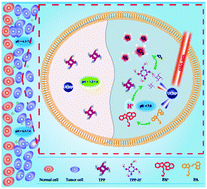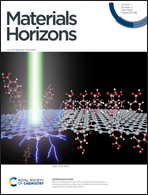Reconstructing the intracellular pH microenvironment for enhancing photodynamic therapy†
Abstract
Acidic tumor microenvironments, characterized by weak acidity outside the cell (pH ∼ 6.5–7.0), have been revealed as a potential therapeutic target with specific acid-responsible materials. However, the intracellular pH of tumor cells is still slightly alkaline (pH ∼ 7.2–7.4), which is not conducive for nanomaterials that respond to acid but should destroy intracellular substances. Here, we proposed a new strategy for reconstructing the intracellular pH microenvironment to enhance photodynamic therapy. Nanomaterials (UCNP@ZIF + TPP + PA) were designed with an NaYF4:Yb:Tm (UCNP) inner core coated by a porous zeolitic imidazolate framework (ZIF-8) outside for photoacid (PA) and acid-responsive porphyrin (TPP) co-loading. Upon 980 nm laser irradiation, the emission light of UCNP activates PA for H+ release, which achieves reconstruction of the intracellular pH environment. In this new acid condition, TPP becomes protonated (TPP-H+), which reduces its aggregation by enhancing its water solubility, and in turn increases singlet oxygen (1O2) production for enhanced tumor killing. Both in vitro and in vivo experiments have proved that UCNP@ZIF + TPP + PA could reconstruct the intracellular pH environment and enhance therapeutic effect of photodynamic therapy (PDT). Reconstructing the intracellular pH by using light is of great significance for acid-responsive nanosystems to destroy intracellular substances and treat tumors. The results also signify the use of such acid-responsive materials for several other disease therapies.



 Please wait while we load your content...
Please wait while we load your content...